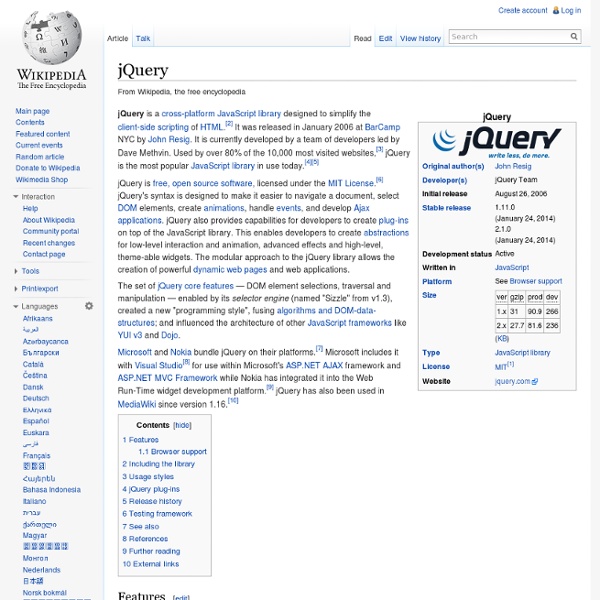Crossfilter
Fast Multidimensional Filtering for Coordinated Views Crossfilter is a JavaScript library for exploring large multivariate datasets in the browser. Crossfilter supports extremely fast (<30ms) interaction with coordinated views, even with datasets containing a million or more records; we built it to power analytics for Square Register, allowing merchants to slice and dice their payment history fluidly. Since most interactions only involve a single dimension, and then only small adjustments are made to the filter values, incremental filtering and reducing is significantly faster than starting from scratch. Example: Airline on-time performance The coordinated visualizations below (built with D3) show nearly a quarter-million flights from early 2001: part of the ASA Data Expo dataset. February 28, 2001 236 mi. +139 min. 304 mi. +83 min. 569 mi. +172 min. 646 mi. +97 min. 370 mi. +73 min. 325 mi. +92 min. +16 min. 361 mi. +75 min. 251 mi. +22 min. 590 mi. +175 min. 283 mi. +60 min. 480 mi. +50 min. 358 mi. +95 min.
Ajax (programming)
Ajax is not a single technology, but a group of technologies. HTML and CSS can be used in combination to mark up and style information. The DOM is accessed with JavaScript to dynamically display, and allow the user to interact with, the information presented. JavaScript and the XMLHttpRequest object provide a method for exchanging data asynchronously between browser and server to avoid full page reloads. In 1996, the iframe tag was introduced by Internet Explorer to load or to fetch content asynchronously. In 1998, Microsoft Outlook Web App team implemented the first component XMLHTTP by client script. Google made a wide deployment of standards-compliant, cross browser Ajax with Gmail (2004) and Google Maps (2005).[6] The term "Ajax" was publicly stated on 18 February 2005 by Jesse James Garrett in an article titled "Ajax: A New Approach to Web Applications", based on techniques used on Google pages.[1] get-ajax-data.js: send-ajax-data.php: jQuery example
jQuery
Raphaël—JavaScript Library
JSON
JSON (/ˈdʒeɪsən/ JAY-sən),[1] or JavaScript Object Notation, is an open standard format that uses human-readable text to transmit data objects consisting of attribute–value pairs. It is used primarily to transmit data between a server and web application, as an alternative to XML. Although originally derived from the JavaScript scripting language, JSON is a language-independent data format. Code for parsing and generating JSON data is readily available in many programming languages. The JSON format was originally specified by Douglas Crockford. History[edit] Although JSON was originally based on a non-strict subset of the JavaScript scripting language (specifically, Standard ECMA-262 3rd Edition—December 1999[8]) and is commonly used with that language, it is a language-independent data format. Though JSON is commonly perceived as being a subset of JavaScript and ECMAScript, it allows some unescaped characters in strings that are illegal in JavaScript and ECMAScript strings.[9] Ajax[edit]
jQuery Autosize
A small, stand-alone script to automatically adjust textarea height. Demo Released under the MIT License, source on Github (changelog) Download Install via NPM npm install autosize Browser compatibility Usage The autosize function accepts a single textarea element, or an array or array-like object (such as a NodeList or jQuery collection) of textarea elements. autosize(document.querySelectorAll('textarea')); autosize(document.querySelector('textarea')); autosize($('textarea')); Methods Life-cycle Events Trouble shooting / FAQ Setting a min-height or max-height Use CSS to specify a min-height and max-height for the textarea element. The rows attribute can also be used to specify a minimum height. Fixing slow or sluggish performance In Webkit, the default focus style for input and textarea elements includes outline-style: auto, which has a blurred drop-shadow like appearance. Initial height is incorrect Autosize needs to be able to calculate the width of the textarea element when it is assigned. Hey,
Creating Sparklines
A sparkline chart is characterized by its small size and data density. Typically displayed without axes or coordinates, sparklines present trends and variations associated with some measurement, in a simple and condensed way. Whereas the typical chart is designed to show as much data as possible, sparklines are intended to be succinct. The example uses the Superstore sample to create a sparkline that shows profit for various product categories over a 12-month period. Step 1 Open a new workbook and connect to the Superstore sample. Step 2 Add the following fields to the view: From the Dimensions pane, drag Order Date to the Columns shelf, and then drag Category to the Rows shelf. Step 3 On the Columns shelf, right-click Order Date and select the first instance of Month. Alternatively, if you want to view the profits over four years on a continuous axis, select the second instance of Month. Step 4 Complete these steps to hide the row and column headers: Step 5
jQuery.dotdotdot, advanced cross-browser ellipsis for multiple line content.



